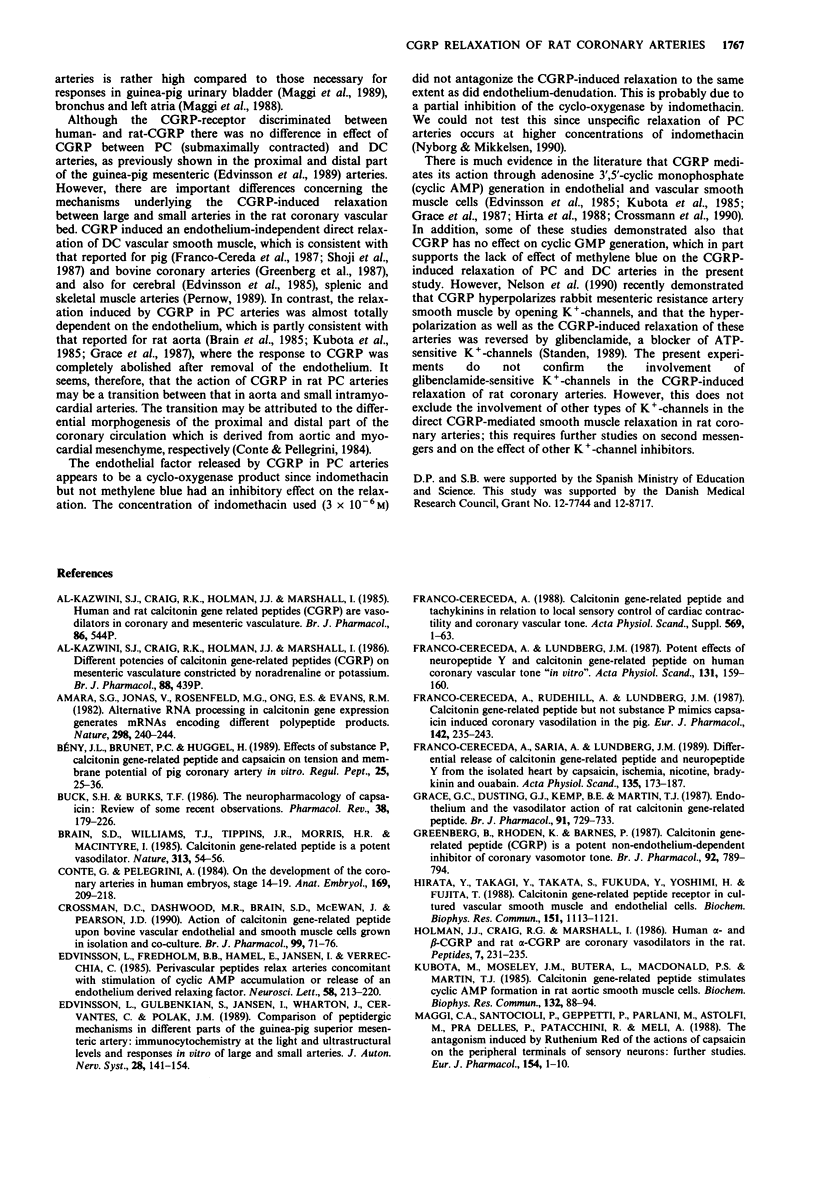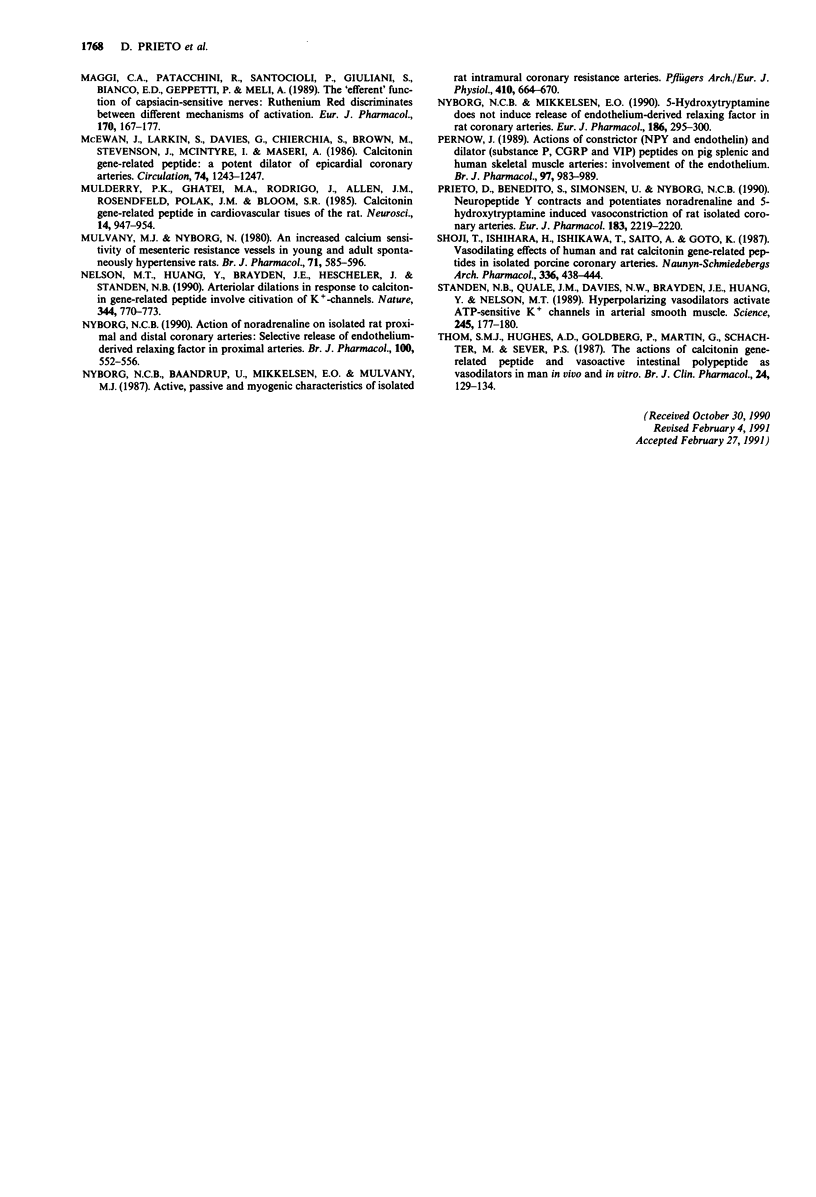Abstract
1. The effects of rat- and human-CGRP and capsaicin were studied in isolated rings of rat proximal epicardial (PC) and distal intramyocardial (DC) coronary arteries. 2. The relaxing effect of rat-CGRP was dependent on the level of vessel tone induced by prostaglandin F2 alpha (PGF2 alpha) in PC but not in DC arteries. Submaximally contracted DC and PC arteries were more sensitive to rat- than human-CGRP. There was no difference in sensitivity to rat- and human-CGRP between PC and DC arteries. 3. Substance P elicited a small relaxation only in 4 of the 6 PC arteries tested. PC and DC arteries were concentration-dependently relaxed by capsaicin. The relaxation was partly inhibited by ruthenium red, thus suggesting that capsaicin causes specific release of CGRP from sensory nerve endings in rat coronary arteries. 4. The relaxant effect of rat-CGRP was antagonized by endothelium removal and indomethacin but not methylene blue in endothelium-intact PC arteries. The relaxation in DC arteries was not affected by any of these treatments, indicating a heterogeneous involvement of the endothelium in CGRP-mediated coronary vasodilatation and the release of a cyclo-oxygenase product in PC arteries in rats. 5. Glibenclamide had no inhibitory effect on the CGRP-induced relaxation of PC and DC arteries, thus excluding the involvement of glibenclamide-sensitive K(+)-channels in the mechanism of action of CGRP in rat coronary arteries.
Full text
PDF




Selected References
These references are in PubMed. This may not be the complete list of references from this article.
- Amara S. G., Jonas V., Rosenfeld M. G., Ong E. S., Evans R. M. Alternative RNA processing in calcitonin gene expression generates mRNAs encoding different polypeptide products. Nature. 1982 Jul 15;298(5871):240–244. doi: 10.1038/298240a0. [DOI] [PubMed] [Google Scholar]
- Brain S. D., Williams T. J., Tippins J. R., Morris H. R., MacIntyre I. Calcitonin gene-related peptide is a potent vasodilator. Nature. 1985 Jan 3;313(5997):54–56. doi: 10.1038/313054a0. [DOI] [PubMed] [Google Scholar]
- Buck S. H., Burks T. F. The neuropharmacology of capsaicin: review of some recent observations. Pharmacol Rev. 1986 Sep;38(3):179–226. [PubMed] [Google Scholar]
- Bény J. L., Brunet P. C., Huggel H. Effects of substance P, calcitonin gene-related peptide and capsaicin on tension and membrane potential of pig coronary artery in vitro. Regul Pept. 1989 Apr;25(1):25–36. doi: 10.1016/0167-0115(89)90245-0. [DOI] [PubMed] [Google Scholar]
- Conte G., Pellegrini A. On the development of the coronary arteries in human embryos, stages 14-19. Anat Embryol (Berl) 1984;169(2):209–218. doi: 10.1007/BF00303151. [DOI] [PubMed] [Google Scholar]
- Crossman D. C., Dashwood M. R., Brain S. D., McEwan J., Pearson J. D. Action of calcitonin gene-related peptide upon bovine vascular endothelial and smooth muscle cells grown in isolation and co-culture. Br J Pharmacol. 1990 Jan;99(1):71–76. doi: 10.1111/j.1476-5381.1990.tb14656.x. [DOI] [PMC free article] [PubMed] [Google Scholar]
- Edvinsson L., Fredholm B. B., Hamel E., Jansen I., Verrecchia C. Perivascular peptides relax cerebral arteries concomitant with stimulation of cyclic adenosine monophosphate accumulation or release of an endothelium-derived relaxing factor in the cat. Neurosci Lett. 1985 Jul 31;58(2):213–217. doi: 10.1016/0304-3940(85)90166-1. [DOI] [PubMed] [Google Scholar]
- Edvinsson L., Gulbenkian S., Jansen I., Wharton J., Cervantes C., Polak J. M. Comparison of peptidergic mechanisms in different parts of the guinea pig superior mesenteric artery: immunocytochemistry at the light and ultrastructural levels and responses in vitro of large and small arteries. J Auton Nerv Syst. 1989 Nov;28(2):141–154. doi: 10.1016/0165-1838(89)90087-8. [DOI] [PubMed] [Google Scholar]
- Franco-Cereceda A. Calcitonin gene-related peptide and tachykinins in relation to local sensory control of cardiac contractility and coronary vascular tone. Acta Physiol Scand Suppl. 1988;569:1–63. [PubMed] [Google Scholar]
- Franco-Cereceda A., Lundberg J. M. Potent effects of neuropeptide Y and calcitonin gene-related peptide on human coronary vascular tone in vitro. Acta Physiol Scand. 1987 Sep;131(1):159–160. doi: 10.1111/j.1748-1716.1987.tb08219.x. [DOI] [PubMed] [Google Scholar]
- Franco-Cereceda A., Rudehill A., Lundberg J. M. Calcitonin gene-related peptide but not substance P mimics capsaicin-induced coronary vasodilation in the pig. Eur J Pharmacol. 1987 Oct 13;142(2):235–243. doi: 10.1016/0014-2999(87)90112-9. [DOI] [PubMed] [Google Scholar]
- Franco-Cereceda A., Saria A., Lundberg J. M. Differential release of calcitonin gene-related peptide and neuropeptide Y from the isolated heart by capsaicin, ischaemia, nicotine, bradykinin and ouabain. Acta Physiol Scand. 1989 Feb;135(2):173–187. doi: 10.1111/j.1748-1716.1989.tb08565.x. [DOI] [PubMed] [Google Scholar]
- Grace G. C., Dusting G. J., Kemp B. E., Martin T. J. Endothelium and the vasodilator action of rat calcitonin gene-related peptide (CGRP). Br J Pharmacol. 1987 Aug;91(4):729–733. doi: 10.1111/j.1476-5381.1987.tb11270.x. [DOI] [PMC free article] [PubMed] [Google Scholar]
- Greenberg B., Rhoden K., Barnes P. Calcitonin gene-related peptide (CGRP) is a potent non-endothelium-dependent inhibitor of coronary vasomotor tone. Br J Pharmacol. 1987 Dec;92(4):789–794. doi: 10.1111/j.1476-5381.1987.tb11382.x. [DOI] [PMC free article] [PubMed] [Google Scholar]
- Hirata Y., Takagi Y., Takata S., Fukuda Y., Yoshimi H., Fujita T. Calcitonin gene-related peptide receptor in cultured vascular smooth muscle and endothelial cells. Biochem Biophys Res Commun. 1988 Mar 30;151(3):1113–1121. doi: 10.1016/s0006-291x(88)80481-9. [DOI] [PubMed] [Google Scholar]
- Holman J. J., Craig R. K., Marshall I. Human alpha- and beta-CGRP and rat alpha-CGRP are coronary vasodilators in the rat. Peptides. 1986 Mar-Apr;7(2):231–235. doi: 10.1016/0196-9781(86)90218-4. [DOI] [PubMed] [Google Scholar]
- Kubota M., Moseley J. M., Butera L., Dusting G. J., MacDonald P. S., Martin T. J. Calcitonin gene-related peptide stimulates cyclic AMP formation in rat aortic smooth muscle cells. Biochem Biophys Res Commun. 1985 Oct 15;132(1):88–94. doi: 10.1016/0006-291x(85)90992-1. [DOI] [PubMed] [Google Scholar]
- Maggi C. A., Patacchini R., Santicioli P., Giuliani S., Del Bianco E., Geppetti P., Meli A. The 'efferent' function of capsaicin-sensitive nerves: ruthenium red discriminates between different mechanisms of activation. Eur J Pharmacol. 1989 Nov 7;170(3):167–177. doi: 10.1016/0014-2999(89)90537-2. [DOI] [PubMed] [Google Scholar]
- Maggi C. A., Santicioli P., Geppetti P., Parlani M., Astolfi M., Pradelles P., Patacchini R., Meli A. The antagonism induced by ruthenium red of the actions of capsaicin on the peripheral terminals of sensory neurons: further studies. Eur J Pharmacol. 1988 Sep 1;154(1):1–10. doi: 10.1016/0014-2999(88)90356-1. [DOI] [PubMed] [Google Scholar]
- McEwan J., Larkin S., Davies G., Chierchia S., Brown M., Stevenson J., MacIntyre I., Maseri A. Calcitonin gene-related peptide: a potent dilator of human epicardial coronary arteries. Circulation. 1986 Dec;74(6):1243–1247. doi: 10.1161/01.cir.74.6.1243. [DOI] [PubMed] [Google Scholar]
- Mulderry P. K., Ghatei M. A., Rodrigo J., Allen J. M., Rosenfeld M. G., Polak J. M., Bloom S. R. Calcitonin gene-related peptide in cardiovascular tissues of the rat. Neuroscience. 1985 Mar;14(3):947–954. doi: 10.1016/0306-4522(85)90156-3. [DOI] [PubMed] [Google Scholar]
- Mulvany M. J., Nyborg N. An increased calcium sensitivity of mesenteric resistance vessels in young and adult spontaneously hypertensive rats. Br J Pharmacol. 1980;71(2):585–596. doi: 10.1111/j.1476-5381.1980.tb10977.x. [DOI] [PMC free article] [PubMed] [Google Scholar]
- Nelson M. T., Huang Y., Brayden J. E., Hescheler J., Standen N. B. Arterial dilations in response to calcitonin gene-related peptide involve activation of K+ channels. Nature. 1990 Apr 19;344(6268):770–773. doi: 10.1038/344770a0. [DOI] [PubMed] [Google Scholar]
- Nyborg N. C. Action of noradrenaline on isolated proximal and distal coronary arteries of rat: selective release of endothelium-derived relaxing factor in proximal arteries. Br J Pharmacol. 1990 Jul;100(3):552–556. doi: 10.1111/j.1476-5381.1990.tb15845.x. [DOI] [PMC free article] [PubMed] [Google Scholar]
- Nyborg N. C., Baandrup U., Mikkelsen E. O., Mulvany M. J. Active, passive and myogenic characteristics of isolated rat intramural coronary resistance arteries. Pflugers Arch. 1987 Dec;410(6):664–670. doi: 10.1007/BF00581329. [DOI] [PubMed] [Google Scholar]
- Nyborg N. C., Mikkelsen E. O. 5-Hydroxytryptamine does not release endothelium-derived relaxing factor in rat isolated coronary arteries. Eur J Pharmacol. 1990 Sep 21;186(2-3):295–300. doi: 10.1016/0014-2999(90)90447-e. [DOI] [PubMed] [Google Scholar]
- Pernow J. Actions of constrictor (NPY and endothelin) and dilator (substance P, CGRP and VIP) peptides on pig splenic and human skeletal muscle arteries: involvement of the endothelium. Br J Pharmacol. 1989 Jul;97(3):983–989. doi: 10.1111/j.1476-5381.1989.tb12040.x. [DOI] [PMC free article] [PubMed] [Google Scholar]
- Shoji T., Ishihara H., Ishikawa T., Saito A., Goto K. Vasodilating effects of human and rat calcitonin gene-related peptides in isolated porcine coronary arteries. Naunyn Schmiedebergs Arch Pharmacol. 1987 Oct;336(4):438–444. doi: 10.1007/BF00164880. [DOI] [PubMed] [Google Scholar]
- Standen N. B., Quayle J. M., Davies N. W., Brayden J. E., Huang Y., Nelson M. T. Hyperpolarizing vasodilators activate ATP-sensitive K+ channels in arterial smooth muscle. Science. 1989 Jul 14;245(4914):177–180. doi: 10.1126/science.2501869. [DOI] [PubMed] [Google Scholar]


